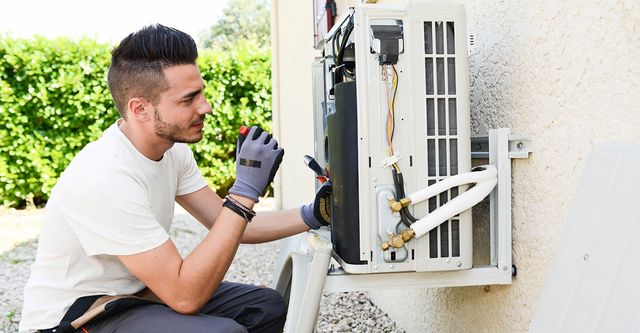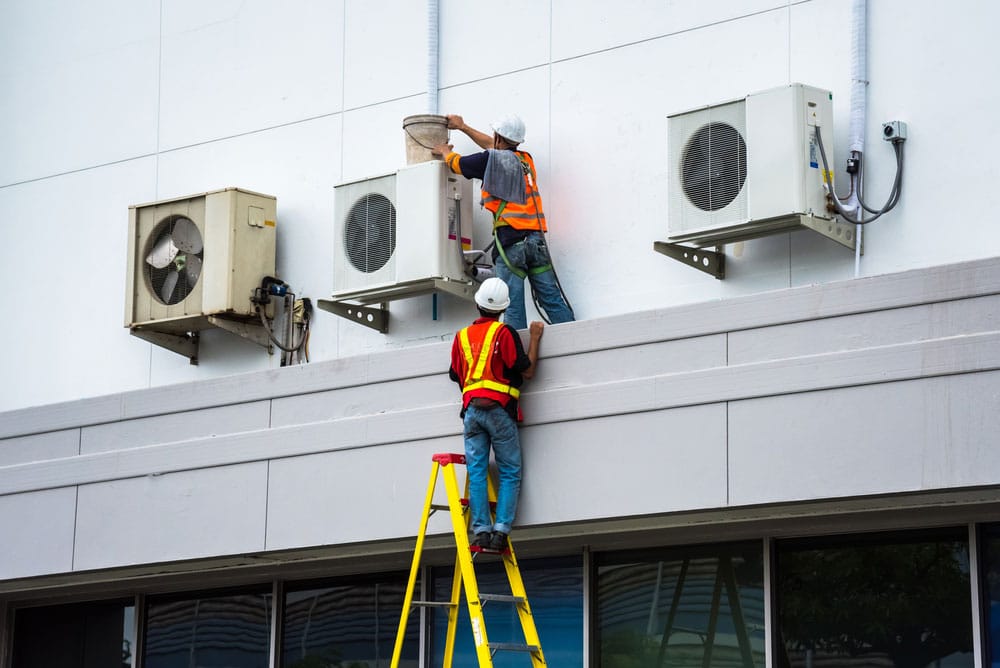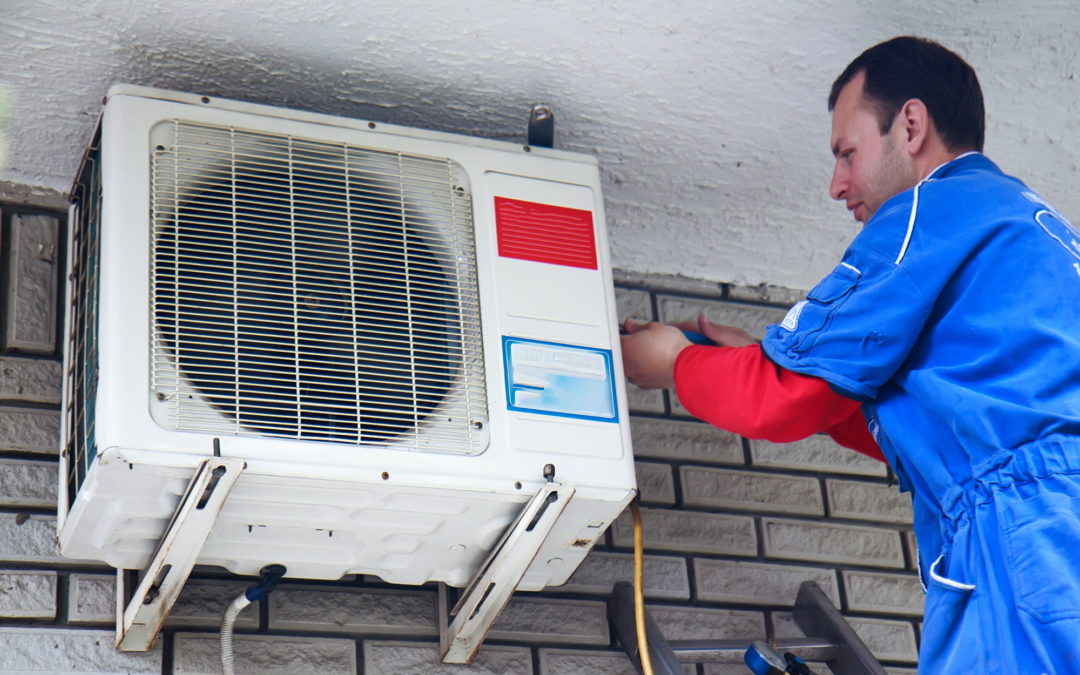If you have actually ever before come across a circumstance where the a/c in your skyscraper seemed to be blowing warm air despite the thermostat being set to cool down, you may be aware of one of the common troubles faced in such structures.
Nonetheless, this problem is just the idea of the iceberg when it pertains to the complexities of a/c repairs in high structures. Comprehending the complex interaction between different variables influencing heating and cooling systems in high-rises is important for effective fixing and upkeep.
Key Takeaways

- Weak airflow in high-rises shows ductwork style problems.
- Thermostat calibration is crucial for precise temperature control.
- Refrigerant leakages effect performance and call for punctual sealing.
- Correct maintenance of condensate water drainage prevents obstructions in tall buildings.
Inadequate Air flow
If you discover weak air movement in your high-rise building, maybe an indication of underlying concerns with the air conditioning system. Common causes of inadequate air movement often originate from airflow limitations within the ductwork design. These limitations can occur because of various reasons such as blockages, inappropriate sizing of air ducts, and even flexes and turns in the ductwork that impede the smooth flow of air.
Among the main elements contributing to airflow restrictions is the design of the ductwork. Improperly made air duct systems can lead to uneven distribution of air throughout the structure, resulting in particular areas obtaining insufficient cooling or heating. Additionally, poor insulation or dripping ducts can even more intensify airflow concerns, creating energy wastage and pain for owners.
To resolve air movement troubles effectively, it's important to have the ductwork evaluated by an expert HVAC specialist. They can determine any type of constraints, leakages, or style problems and recommend suitable solutions to enhance air movement and boost the overall performance of the a/c system in your skyscraper.
Thermostat Malfunctions
When experiencing thermostat breakdowns in high-rise buildings, specialist intervention is vital to ensure the capability of the cooling system. Defective wiring can result in unreliable temperature readings, triggering inconsistent temperatures throughout the building. Sensor calibration is important to assure that the thermostat accurately mirrors the ambient temperature level, avoiding unnecessary air conditioning or heating. Additionally, problems with sensing unit calibration can result in the system running longer than required, affecting energy efficiency.
To attend to thermostat breakdowns effectively, think about the following:
- Look for faulty circuitry that may be creating temperature inconsistencies.
- Frequently adjust sensing units to keep precise temperature readings.


- Maximize thermostat settings for boosted power effectiveness.
- Ensure appropriate installment of the thermostat to stop malfunctions.
- Talk to heating and cooling professionals to detect and solve complicated thermostat issues quickly.
Refrigerant Leaks
Dealing with refrigerant leaks immediately is vital for maintaining the performance of your a/c system in skyscrapers. Cooling agent plays a vital duty in the cooling process by taking in and launching warmth, yet leakages can interrupt this cycle. When refrigerant leakages take place, the system's efficiency decreases, causing higher power consumption and decreased cooling capacity. Monitoring cooling agent stress is crucial to discovering leakages early. A decrease in stress can show a leak, triggering prompt fixings to stop additional damage.
Leak detection techniques such as making use of digital leakage detectors or ultraviolet dye can help identify the resource of the leak. As soon as determined, the leakage needs to be sealed without delay to stop refrigerant loss and guarantee the very best system performance. Routine maintenance checks can also help avoid leakages by recognizing potential weak points in the system before they become significant issues. By attending to refrigerant leaks quickly and carrying out correct leakage discovery measures, you can maintain the effectiveness of your a/c system in high-rise buildings and avoid expensive repairs down the line.
Irregular Cooling Distribution
Keeping regular air flow is necessary for achieving even cooling circulation in skyscrapers. When unequal cooling takes place, certain areas might come to be annoyingly warm while others stay cold, bring about tenant dissatisfaction.
To address this issue effectively, take into consideration the following:
- Thermostat Placement: Verify thermostats are located away from heat sources or chilly drafts to properly determine the temperature and manage cooling.
- Balancing Dampers: Frequently check and readjust stabilizing dampers to control the quantity of air flow to every area, advertising well balanced cooling throughout the structure.
- Correct Insulation: Inspect insulation around ductwork to stop air leak, maintaining the most effective temperature control and efficient air blood circulation.
- Air Filter Upkeep: Tidy or change air filters routinely to prevent obstructions that can prevent airflow and hinder even cooling circulation.
- Heating And Cooling System Zoning: Make use of zoning systems to split the structure into separate areas with specific temperature level controls, making certain each space gets the appropriate amount of cooling.
Condensate Drain Issues
Frequently inspect and clear condensate water drainage systems to avoid prospective blockages and warranty optimal operating in high-rise buildings. Blocked pipelines are an usual concern in a/c systems, especially in skyscrapers where the condensate water drainage lines can run fars away. air conditioner not working To stay clear of obstructions, it's critical to arrange routine upkeep checks.
Begin by aesthetically examining the drainage lines for any type of indications of blocking or buildup. Additionally, purge the lines with a mix of water and bleach to avoid algae and mold and mildew growth, which can lead to obstructions.
Maintenance pointers for condensate drain systems include mounting a drain pan therapy to stop microbial development, regularly altering air filters to preserve correct air movement, and making sure that the water drainage lines have appropriate incline for water to move freely.
If you see any kind of signs of an obstructed condensate drain, such as water leakages or minimized cooling efficiency, attend to the concern without delay to stay clear of more damage to the a/c system. By remaining proactive with upkeep, you can stop pricey repair work and assurance reliable operation of the a/c system in high-rise buildings.
Frequently Asked Concerns
Can Cooling Services in Skyscraper Be Even More Expensive Than in Single-Family Homes or Low-Rise Structures?

A/c repairs in high-rise buildings can without a doubt be extra pricey compared to single-family homes or low-rise buildings. The complexity of the systems and the trouble in accessing systems in tall structures can drive up the repair work expenses.
To mitigate these expenses, think about normal maintenance suggestions like transforming filters regularly and organizing specialist evaluations. Preventative care can aid determine issues early and stay clear of costly repair services down the line.
Just How Can Residents in Skyscraper Guarantee Appropriate Upkeep of Their Cooling Equipments to Prevent Usual Problems?
To guarantee your a/c system in a high-rise building runs efficiently, adhere to these maintenance suggestions.
Maintain filters clean to enhance energy performance and air high quality. Look for leaks on a regular basis and timetable professional examinations every year. Use a dehumidifier to control humidity levels.
Exist Any Kind Of Details Obstacles or Difficulties Related To Repairing A/c Systems in High-Rise Buildings Compared to Other Sorts Of Structures?
When repairing air conditioning systems in skyscrapers, there specify challenges to take into consideration. Safety and security regulations have to be strictly followed to assure the well-being of homeowners and workers.
Ease of access obstacles may arise as a result of the height of the building, making it more difficult to reach certain areas for upkeep.
Noise worries are also widespread as the sound from the system can take a trip quickly in between floors.
Maintaining energy performance is crucial in these high frameworks to maintain prices down.
What Are Some Possible Long-Term Consequences of Neglecting Air Conditioning Repairs in a High-Rise Building?
If you forget air conditioning repairs in a high-rise building, prospective risks can consist of decreased energy effectiveness, resulting in higher utility prices.
Furthermore, bad upkeep can influence interior air top quality, causing pain and health and wellness concerns for occupants.
It's necessary to address these problems quickly to guarantee the correct functioning of the system and preserve a comfortable setting for everyone in the structure.
Exist Any Type Of Details Rules or Building Codes That Govern Air Conditioning Fixes in High-Rise Buildings That Residents Should Understand?
When it concerns air conditioning repair work in skyscrapers, citizens need to understand specific guidelines and building regulations. These standards control the upkeep of HVAC systems, ensuring security and effectiveness.
Conclusion
In general, preserving correct cooling in high-rise buildings can be a difficulty because of usual issues like poor air movement, thermostat malfunctions, refrigerant leaks, uneven cooling circulation, and condensate drain concerns.
Regular upkeep and prompt repair work are vital to assure the comfort and security of residents. By dealing with these problems in a timely fashion, structure proprietors can protect against pricey repair work and safeguard a pleasant indoor environment for all citizens.
